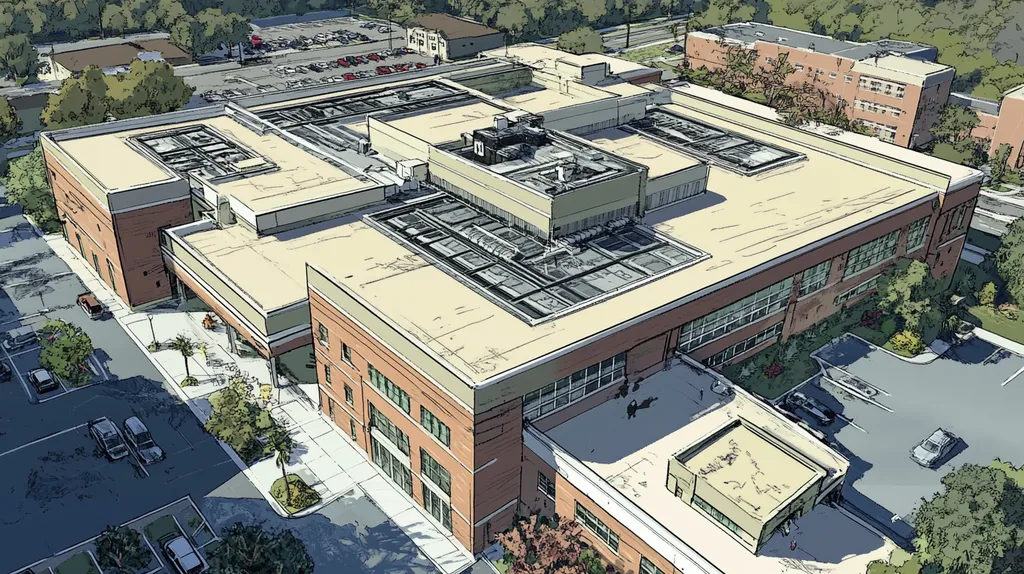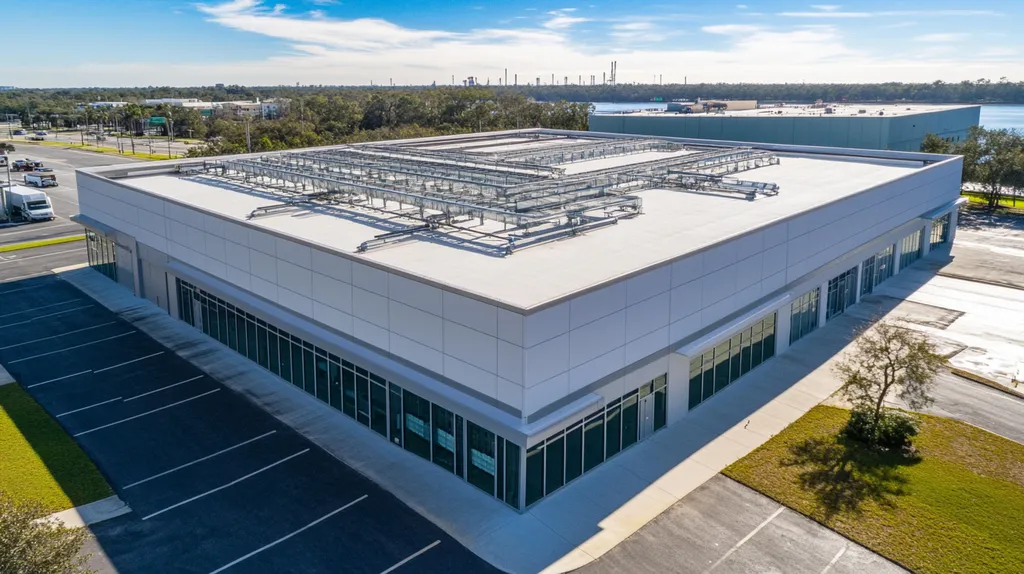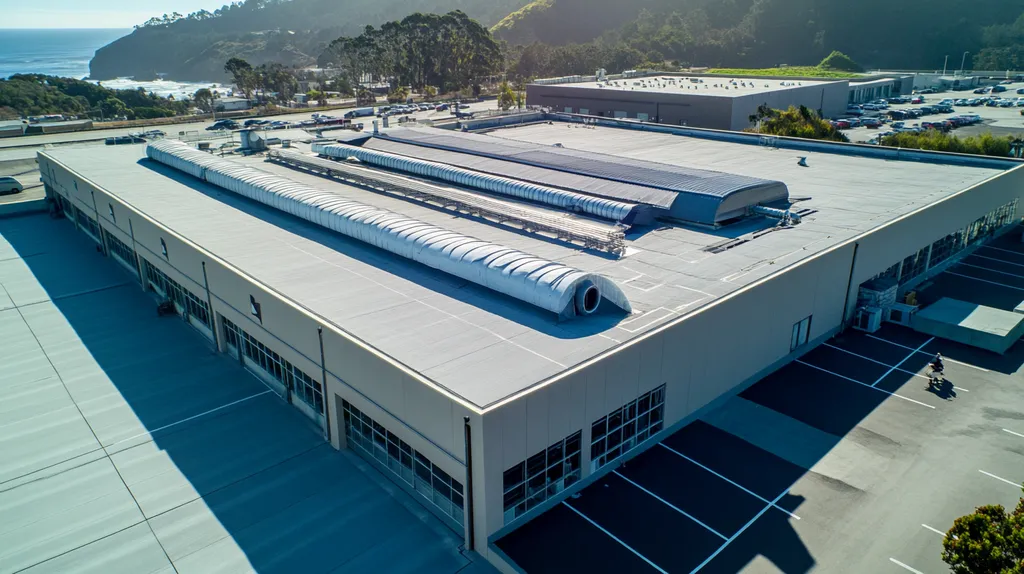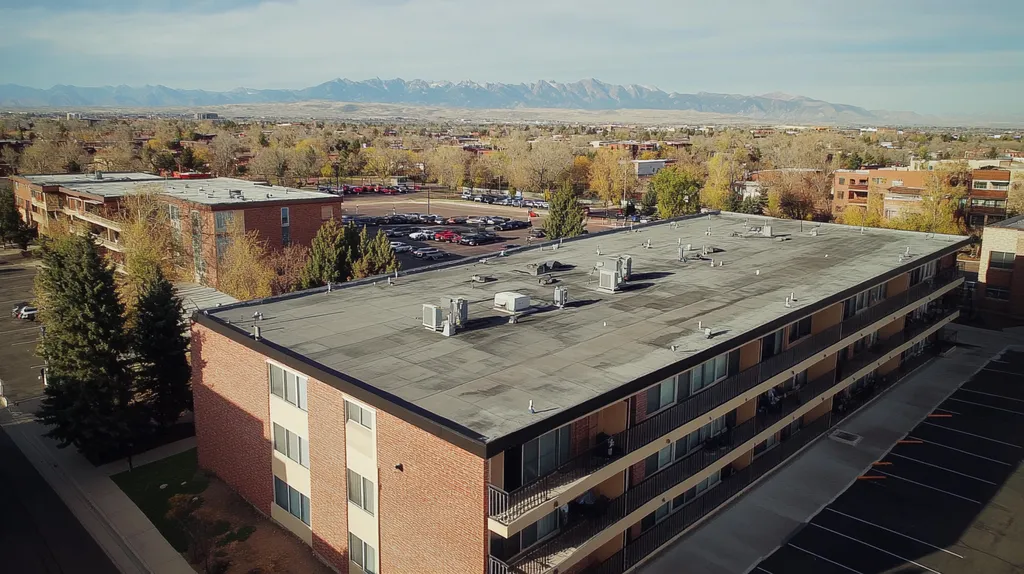Industrial property owners lose an estimated $3.6 billion annually due to energy inefficiency in roofing systems, with heating costs representing nearly 40% of this waste.
Despite significant technological advances in energy-efficient roofing, persistent industry myths continue to drive poor decision-making and missed savings opportunities.
This comprehensive analysis examines common misconceptions about industrial roofing solutions, their costly implications, and evidence-based alternatives that can reduce heating expenses by up to 30%.
SECTION 1: COMMON MISCONCEPTIONS
As heating costs continue to rise, industrial property owners are confronted with critical decisions regarding their roofing solutions. Misunderstandings about energy-efficient options can obscure judgment, potentially leading to costly errors. For instance, a study reveals that companies neglecting reflective coatings may waste over 30% on energy bills each year. It’s essential to clarify these common misconceptions to make informed decisions that can lower heating costs and enhance roof performance. This section will explore three prevalent myths that can negatively impact energy efficiency.
Metal Roofs Increase Heat
Many people assume that metal roofs increase heat retention, causing discomfort and high energy bills. However, modern metal roofing systems are designed to reflect sunlight, significantly decreasing heat absorption. Research has shown that they can lower roof surface temperatures by as much as 20% compared to traditional roofing materials.
The confusion often arises from older metal roof installations that lacked essential reflective coatings. Today’s metal roofs utilize advanced technologies that enhance energy efficiency through highly reflective surfaces. By adopting these modern solutions, property owners can achieve substantial savings on heating costs.
Investing in a metal roof not only assures durability but also aids in reducing heating expenses. Embracing the advancements in reflective metal roofing allows property owners to manage energy consumption effectively.
Neglecting to consider metal roofs could lead to higher operational costs and missed sustainability opportunities. Recognizing the energy efficiency potential of metal roofs is a critical step toward more informed roofing choices.
Green Roofs Are Impractical
Many believe that green roofs are impractical for industrial applications due to perceived high costs and maintenance demands. Nevertheless, recent innovations illustrate that green roofs can offer significant advantages, particularly in lowering heating and cooling expenses.
Serving as natural insulators, green roofs help moderate indoor temperatures, directly impacting energy usage. Studies indicate that buildings equipped with green roofs can save up to 20% on energy costs associated with temperature control. Additionally, green roofs often extend the lifespan of the underlying roofing materials.
While the initial investment for a green roof may be higher, the potential returns through energy savings and tax incentives make them financially sound. Overlooking this innovative option can lead to long-term financial drawbacks.
Property owners should view green roofs as a progressive solution that combines sustainability with cost-effectiveness. By adopting green roofs, businesses can set new benchmarks for ecological responsibility within the industrial sector.
Reflective Coatings Are Ineffective
Despite a prevailing belief that reflective coatings do not significantly enhance energy efficiency, this is a misconception. Reflective coatings are engineered to minimize solar heat gain, making them essential for reducing heating costs. Research shows that buildings treated with reflective coatings can experience roof temperature reductions of up to 50°F during peak summer months.
In addition to lowering temperatures, these coatings protect roofing materials from environmental stressors, enhancing their longevity. This added durability translates to lower maintenance and replacement costs, offering further financial benefits for property owners.
Failing to implement reflective coatings can lead to inflated energy bills and frequent roof repairs or replacements. Dismissing the effectiveness of these coatings can severely hinder long-term sustainability and cost-efficiency.
Utilizing reflective coatings represents a proactive step towards reducing heating expenses while extending the life of roofing systems. Educating stakeholders about these advantages is vital for fostering energy-saving choices in the industrial roofing sector.
SECTION 2: PRACTICAL IMPLICATIONS
The choice to invest in energy-efficient roofing carries significant consequences for both operational costs and environmental sustainability. Research indicates that nearly 30% of a building’s energy consumption stems from heating and cooling needs. By adopting energy-efficient roofing solutions, facility managers can not only reduce heating costs but also improve insulation effectiveness and enhance stormwater management. These aspects are crucial for optimizing overall building performance and realizing long-term financial benefits.
Impact on Cooling Costs
Cooling costs often go underappreciated in industrial settings, where roof performance is vital for effective temperature control. Traditional roofing materials absorb heat from the sun, which drives up demand for air conditioning. By opting for reflective or “cool” roofing materials, property owners can significantly lower rooftop temperatures.
Research shows that reflective roofing materials can reduce surface temperatures by as much as 30 degrees Fahrenheit. This translates to a lower overall cooling load, enabling facilities to keep their interiors cooler and extend the lifespan of HVAC systems.
The financial benefits of reduced cooling costs can be significant as energy prices continue to rise. For budget-conscious property managers, these savings are increasingly important.
In summary, the choice of roofing material can lead to substantial decreases in cooling expenses, underscoring the importance of selecting energy-efficient options for industrial applications.
Effects on Building Insulation
The efficiency of building insulation is closely linked to the roof system in place. Poorly insulated roofs can elevate both heating and cooling demands, resulting in higher energy costs. Energy-efficient roofing products provide improved thermal resistance, enhancing the entire building envelope.
Installing high-R-value insulation beneath a reflective roof contributes to more stable indoor temperatures. This efficiency lowers the energy required for heating and cooling, which ultimately reduces utility expenses.
Beyond cost savings, superior insulation improves occupant comfort and allows for better control over indoor air quality and temperature.
Effective insulation also aligns with environmental goals by curbing greenhouse gas emissions associated with excessive energy use.
Influence on Stormwater Management
Stormwater management is a critical yet often neglected element of roofing systems, impacting both environmental quality and structural integrity. Conventional roofs can increase runoff, potentially leading to flooding and compromising water quality in nearby areas.
Energy-efficient solutions, including green roofs or permeable materials, can significantly alleviate stormwater runoff. These systems either absorb rainwater or release it slowly, reducing the pressure on local drainage systems.
Moreover, innovative roofing options can create green spaces that enhance air quality and foster biodiversity. This dual capability strengthens energy efficiency while providing valuable environmental benefits.
Incorporating effective stormwater management into roofing choices helps support sustainability objectives and fosters a reputation for environmental responsibility among industrial property owners.
SECTION 3: COST OF MISINFORMATION
The impact of misinformation in industrial roofing can have dire financial consequences. According to the U.S. Department of Energy, poor roofing choices can lead to wasting up to 30% of energy used in commercial buildings. Misunderstanding energy-efficient options can result in higher energy consumption, increased maintenance expenses, and missed opportunities for valuable rebates and incentives. Clarifying these misconceptions is vital for making informed decisions that improve both roof performance and operational savings.
Higher Energy Consumption
Many industry professionals still operate under the assumption that traditional roofing materials can provide sufficient energy efficiency. This belief can be misleading, as such materials often lack essential insulating properties. Consequently, energy bills can rise significantly because poorly insulated roofs allow heat to escape in winter and trap it in summer.
For example, facilities with conventional roofs may face heating costs that are 20% higher than those equipped with energy-efficient roofing solutions. Misguided choices stem from misconceptions, causing financial strain on property owners over time.
Reliance on outdated roofing not only undermines sustainability efforts but can also increase demand on local energy grids, which may contribute to rising energy rates for all consumers. Adopting modern materials, such as reflective membranes or advanced insulation, can significantly address these issues. With proper education on energy-efficient options, facility managers can reduce expenses while promoting environmental responsibility.
Increased Maintenance Costs
Misinformation often leads to neglect in essential maintenance for roofing systems. Property managers may not realize that energy-efficient roofs require different maintenance procedures compared to traditional setups, creating the potential for higher repair costs later on.
A single leak in a poorly insulated roof can result in substantial internal damage, leading to expensive repairs. Energy-efficient roofing is generally designed for durability and ease of maintenance, but without adequate knowledge, property owners may fail to take full advantage of these benefits.
Moreover, misunderstanding energy-efficient technologies may result in selecting inferior materials that deteriorate faster. Opting for the cheapest solution can increase ongoing repair and replacement costs. When property managers understand the maintenance needs of energy-efficient roofs, they can minimize routine upkeep and prolong roof lifespan while reducing overall costs.
Missed Incentives and Rebates
The financial advantages of energy-efficient roofing extend beyond operational savings as there are various incentives available. Unfortunately, a lack of awareness about these programs can cause property owners to overlook significant rebates and tax credits offered by federal and state agencies.
For instance, Energy Star certification incentivizes buildings that use reflective roofing materials, yet many owners miss these benefits due to misinformation. Failing to pursue these incentives can decrease overall return on investment, especially when many energy-efficient solutions come with a higher upfront cost.
Understanding available financial support is essential to easing transitions and encouraging investments in long-term savings. By being informed about the landscape of incentives, facility managers can significantly lower their initial costs while boosting their roofing’s energy efficiency. Staying updated ensures that properties not only comply with energy standards but also enjoy financial rewards.
SECTION 4: REALITY CHECK
The urgency for energy-efficient roofing in industrial settings has never been more pressing. With energy costs on the rise, facility managers must prioritize sustainable roofing solutions to manage expenses effectively. Research shows that reflective roofing can cut energy consumption by up to 25%. Understanding the actual benefits of different roofing options, including metal roofing reflectivity, green roofs, and solar roofing efficiencies, is crucial for informed decision-making. This section sheds light on these realities to dispel common misconceptions.
Metal Roofing Reflectivity
Underestimating metal roofing’s energy-saving capabilities can be a costly oversight. Conventional metal roofs can reflect as much as 70% of solar radiation, leading to significant reductions in cooling costs. This is particularly critical in warmer climates, where air conditioning expenses can escalate quickly during peak summer months.
The color and finish of metal roofing directly impact its reflective efficacy. Choosing lighter shades in combination with specialized coatings can enhance performance. For instance, a white or light-colored metal roof can noticeably reduce indoor temperatures, leading to faster returns on roofing investments.
Additionally, many facilities overlook the long-term maintenance savings provided by reflective metal roofing. These durable materials not only lower energy costs but also reduce the frequency of replacements, adding to their economic appeal. Making the switch to reflective metal roofing can ensure substantial savings not just on energy bills, but on long-term maintenance costs as well.
Disregarding the advantages of metal reflectivity can leave facilities exposed to rising energy costs. Adhering to energy codes and standards may also unlock financial incentives, enhancing overall return on investment. Property owners need to recognize the enduring economic benefits that reflective metal roofing can provide.
Green Roof Energy Savings
While often perceived as a luxury, green roofs can offer financial sense for industrial buildings. By incorporating vegetation, these roofs significantly enhance insulation properties, leading to reduced heating and cooling costs. Research indicates that green roofs can lower indoor temperatures by up to 10 degrees Fahrenheit.
These systems create a natural thermal barrier, minimizing heat transfer between the interior and exterior of facilities. This results in considerable energy savings during both summer and winter seasons. Additionally, green roofs help mitigate the urban heat island effect, contributing to broader urban sustainability efforts.
Another significant advantage lies in stormwater management. Green roofs absorb rainwater, reducing runoff and alleviating pressure on local drainage systems. This can translate to lower sewer fees and associated costs, a benefit that many property owners fail to fully appreciate.
Despite higher upfront costs, the long-term benefits of green roofs include lower lifecycle expenses and extended longevity. Ultimately, adopting green roofs should not be viewed merely as a trend, but as a transformative strategy for achieving energy efficiency.
Solar Roofing Efficiency
Solar roofing technology is evolving rapidly, yet misconceptions about cost persist. Many property owners still think that solar panels are unaffordable. In reality, the cost of solar installations has dropped by over 80% in the last decade, making them a feasible investment.
Solar energy systems can substantially reduce energy expenses, with facilities reporting savings of up to 50% on energy bills. When combined with available tax incentives, the financial justification for solar installations becomes even stronger.
Integrating solar roofing also helps achieve sustainability objectives. In an era of increasing environmental awareness, having solar solutions can enhance a facility’s marketability. This commitment to renewable energy is appealing to tenants and customers who prioritize eco-friendly practices.
Ignoring solar technology can hinder competitiveness in a market that increasingly values sustainability. With financing options such as power purchase agreements (PPAs) and solar leasing, barriers to adoption are diminishing. Property managers should actively consider solar roofing as a vital component of their energy strategy.
SECTION 5: EVIDENCE-BASED ALTERNATIVES
As energy costs continue to climb, addressing heating expenses in industrial roofing has become a pressing concern. Research reveals that inadequately insulated roofs can result in energy losses of up to 30%, straining operational budgets significantly. By embracing innovative roofing solutions, property owners can not only reduce heating expenses but also enhance overall building efficiency. This section delves into three viable alternatives: cool roofing systems, thermoplastic single-ply membranes, and solar integrated roofing.
Cool Roofing Systems
Cool roofing systems are engineered to reflect more sunlight and absorb significantly less heat than conventional roofs. This technology is especially beneficial in urban environments, where the heat island effect can drive energy costs even higher. According to the Cool Roof Rating Council, these systems can decrease roof surface temperatures by as much as 50 degrees Fahrenheit.
This reduction in temperature translates directly to lowered cooling costs during summer. Given that industrial buildings often feature large roof areas, the potential for energy savings is substantial. Additionally, by reflecting solar radiation, cool roofs can extend the lifecycle of roofing materials.
Numerous manufacturers offer cool roofing products that comply with strict energy efficiency guidelines, ensuring property owners can meet sustainability standards. Opting for a cool roofing system may also qualify owners for valuable tax incentives, further improving return on investment.
Adopting cool roofs demonstrates a commitment to energy efficiency, positively impacting a company’s public image while enhancing operational efficiency.
Thermoplastic Single-Ply Membranes
Thermoplastic single-ply membranes, such as TPO and PVC, are becoming increasingly popular for their durability and energy-saving properties. These materials are well-suited for industrial roofs, exhibiting high reflectivity and minimizing heat absorption, consistently lowering heating and cooling expenses.
When installed, thermoplastic membranes help reduce overall energy consumption, improving a building’s efficiency. These membranes offer excellent chemical and puncture resistance, making them ideal for harsh industrial environments.
Importantly, thermoplastic roofing systems can be installed with minimal interruptions to business operations. Their seamless design eliminates vulnerabilities typical of traditional roofing systems, enhancing both lifespan and performance.
Facilities utilizing thermoplastic single-ply membranes often report energy savings of up to 20% on heating and cooling bills, presenting a strong financial case for this modern roofing solution.
Solar Integrated Roofing
Solar integrated roofing merges traditional roofing functions with solar energy generation capabilities. This dual-purpose approach reduces dependence on standard energy sources while potentially allowing excess energy to be reinjected into the grid. Given the rising energy costs, solar integrated roofing is an appealing option for industrial property owners.
This innovative solution offers substantial long-term savings on energy bills. A well-executed solar integrated roof can effectively pay for itself within a decade, thanks to energy savings and government incentives.
Beyond the financial advantages, solar roofs contribute to sustainability targets by lowering the carbon footprint associated with industrial operations. They also enhance a property’s market value, as eco-friendly features become increasingly attractive to tenants and consumers.
By adopting solar integrated roofing, facility managers invest in their buildings while aligning with the global push toward renewable energy solutions, positioning themselves as leaders in sustainability practices.
SECTION 6: TEST AND VERIFY
The need to enhance energy efficiency in industrial roofing systems is more pressing than ever. In fact, studies indicate that implementing energy-efficient roofing solutions can reduce heating costs by up to 30%. Property owners must conduct regular testing and verification of their roofing systems to ensure these savings are realized. This section emphasizes the importance of energy audits, continuous performance monitoring, and learning from real-world success stories.
Conducting Energy Audits
Regular energy audits are vital for identifying inefficiencies in industrial roofing. They assess various factors such as insulation quality, air leaks, and overall thermal performance. By targeting specific problem areas, property owners can implement improvements that lead to reduced heating expenses.
Engaging professional energy audit services offers comprehensive performance analyses and identifies potential upgrades, such as enhanced insulation or reflective coatings. For instance, a manufacturing plant in the Midwest cut its energy consumption by over 20% after making adjustments recommended during an energy audit.
Additionally, energy audits establish a foundational benchmark for future improvements. This ongoing process ensures roofing systems remain efficient as energy standards evolve. Neglecting this step can result in rising costs and decreased roof performance over time.
In summary, conducting regular energy audits is essential for maximizing roof efficiency and ensuring long-term savings.
Monitoring Roof Performance
Continuous performance monitoring is crucial to understand how effectively a roofing system operates under real-world conditions. Utilizing sensors and smart technology enables the collection of real-time data on temperature, moisture levels, and insulation performance. This information helps facility managers proactively address issues before they escalate into costly repairs.
For example, monitoring systems can indicate when a roof starts losing its insulating effectiveness, prompting timely maintenance or upgrades. Facilities that adopted continuous monitoring often report significant energy savings, quantifying these benefits in annual energy assessments.
Moreover, comparing performance data over time empowers managers to fine-tune energy strategies for improved operational efficiency. Without monitoring, minor issues can escalate into major inefficiencies, leading to increased costs in the long run.
Ultimately, regular performance monitoring enhances energy efficiency and preserves the integrity of roofing systems.
Case Studies and Success Stories
Real-world examples highlight the significance of testing and verification in achieving energy savings. One notable instance involved a manufacturing facility that transitioned to a cool roofing system. Upon implementing a routine assessment schedule, they found that their roof’s reflective properties were fading faster than expected.
After completing necessary upgrades, they achieved a 25% reduction in heating costs, showcasing the financial benefits of proactive maintenance. Another case involved a distribution center that conducted an energy audit, revealing insulation gaps that were raising heating demands. By rectifying these gaps, they realized annual savings of approximately $12,000.
These success stories emphasize the tangible benefits of fostering a culture of testing and verification. They serve as compelling reminders of the financial and operational advantages that come from diligent oversight and well-informed decision-making.
Looking Ahead
Industrial roofing inefficiencies currently waste over $3.6 billion annually in unnecessary heating costs across the United States.
By implementing evidence-based energy-efficient solutions, facility managers can reduce heating expenses by 20-30% while extending roof lifespans by up to 15 years.
The myths surrounding metal roofing, green roofs, and reflective coatings continue to drive misguided decisions that impact both operational costs and environmental sustainability.
As energy prices rise and environmental regulations tighten, industrial property owners must prioritize verified roofing solutions that deliver measurable results.
The technology exists today to dramatically reduce heating costs through improved roofing systems – the critical factor is taking action based on evidence rather than industry misconceptions.
FREQUENTLY ASKED QUESTIONS
Q. Does a commercial roof made of metal increase heat?
A. Modern metal roofs reflect sunlight rather than retain heat. They are designed with advanced reflective coatings that can lower surface temperatures by 20%, leading to reduced heating costs. Relying on outdated assumptions about metal roofs may result in missed opportunities for energy savings.
Q. How does an industrial roof impact cooling costs?
A. The choice of roofing material can significantly affect cooling expenses. Reflective roofing materials can lower surface temperatures by up to 30°F, decreasing the cooling load on HVAC systems. This helps prolong the system’s lifespan and yield long-term cost savings as energy prices continue to rise.
Q. Can poor roofing choices increase energy consumption in commercial roofs?
A. Yes, using traditional roofing materials can lead to higher energy consumption due to inadequate insulation. Poorly insulated roofs allow heat to escape in winter and trap it in summer, resulting in energy bills that can exceed 20% compared to energy-efficient options.
Q. Do green roofs have practical applications for industrial buildings?
A. Green roofs offer significant advantages, particularly in energy efficiency and stormwater management. They function as natural insulators, potentially lowering indoor temperatures by up to 10°F. Their ability to absorb rainwater also helps reduce runoff, making them practical for industrial applications.
Q. What are the effects of reflective coatings on roofing systems?
A. Reflective coatings significantly enhance energy efficiency by minimizing solar heat gain. Studies indicate that roofs with these coatings can experience a temperature reduction of up to 50°F during summer, which helps extend the life of roofing materials and reduces the need for maintenance.
Q. How important are energy audits for commercial roofing?
A. Energy audits are essential for identifying inefficiencies in commercial roofing systems. They provide insights into insulation quality and highlight areas needing improvement, helping property owners to decrease heating costs and enhance energy efficiency through targeted upgrades.
Q. What are some new energy-efficient roofing alternatives for industrial properties?
A. Innovative options include cool roofing systems, thermoplastic single-ply membranes, and solar integrated roofing. These alternatives enhance insulation, reduce energy consumption, and can contribute to significant long-term cost savings, making them viable choices for modern industrial properties.











